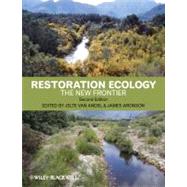- ISBN: 9781444336368 | 1444336363
- Cover: Paperback
- Copyright: 5/21/2012
Background, Aims, and Outline Roughly thirty years old now, the science and practice of ecological restoration are coming of age. They are no longer a "luxury" for rich countries or rich people, but rather an increasingly important and well-integrated component in the science, business, practice, and politics of biodiversity conservation, ecosystem management, societal adaptation to climate change, and legislated mitigation for ecological and environmental damage related to economic development, and/or pollution or other misbehaviour that affect ecosystems, ecosystem services, and biodiversity. The interdisciplinary academic field, the related professions, and the broad-based social movement promoting ecological restoration of degraded ecosystems are indeed spreading their ''wings'', so to speak, in dozens of countries around the world. But there is still a long way to go to achieve integration and application, and the underpinning science, restoration ecology, has a huge role to play. The proposed book is an enlarged, enhanced, and updated edition of the first university level textbook to have appeared on restoration ecology in any language. As before, the book is designed for senior undergraduate and graduate level courses in a wide variety of disciplines related to ecology, applied ecology, and environmental studies, especially for faculties in Europe, North America, Australia and New Zealand. It will also provide a solid scientific background for managers and professionals involved in protected area, park, or nature reserve management where restoration is being contemplated, as well as practitioners of ecological restoration in governmental and non-governmental organisations. We use the classic biome-by-biome approach that will help readers quickly find the specific settings they are most interested in, and compare the barriers and options existing between biomes. As in the first edition, the majority of the chapters deal specifically with European biomes and ecosystems, but the global perspective is always at the background. In addition, two new invited chapters deal with specific ecosystems and contexts common in North America and Australia, namely arid and semi-arid lands. One invited chapter will deal with ecological restoration of tropical forests, especially in the Neotropics - a topic increasingly of interest to restorationists in the US and Europe. In Australia, of course, there is a region of tropical forests in Queensland, so this chapter will be of interest there as well. However, we will not go into depth on socio-economic issues related to ecological restoration, but instead the reader is referred to Aronson et al., 2007. Nor do we discuss in detail the principles, values and structure of the emerging profession of ecological restoration, so as to avoid overlap with Clewell and Aronson, 2007.) The editors will work with contributing authors to achieve even greater coherency, consistency, and clear language throughout the volume. We will also increase the number of boxes, photos and other visual aids employed, so that the book can be used in first-year courses as well as workshops, special training courses and master classes. Finally, we will provide short introductory texts for each of the four parts of the book and a glossary, two features that were missing from the first edition. For this reason, we think the new edition will be complementary to - and competitive with - the Island Press volume Falk et al. (2006) that is currently used in at least 36 different university courses on restoration in the USA. Throughout the book, the editors and authors will explore to what extent currently available ecological concepts and theories can enrich the practice of ecological restoration. The majority of the chapters in the book therefore are devoted to the science of restoration ecology, but the hands-on practice of ecological restoration of degraded, disturbed or destroyed ecosystems is always present in the background. An outline of chapters and intended contributors is given in Table 1. Here, we briefly present the aims and the contents of the new edition.







